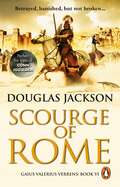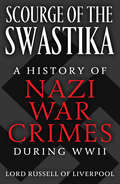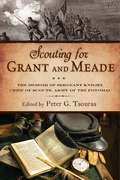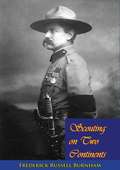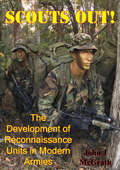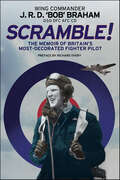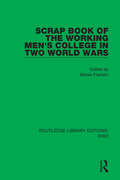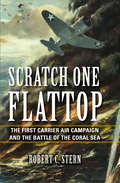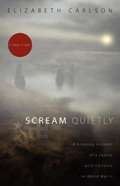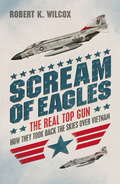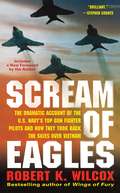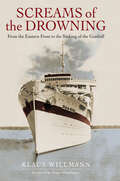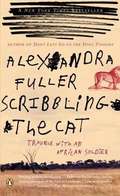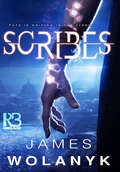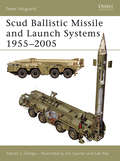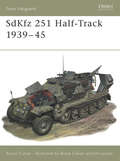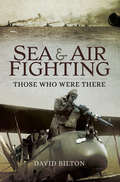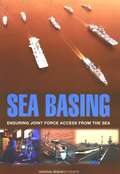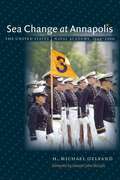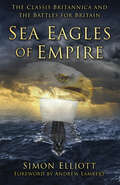- Table View
- List View
Scourge of Rome: (Gaius Valerius Verrens 6): a compelling and gripping Roman adventure that will have you hooked to the very last page (Gaius Valerius Verrens #6)
by Douglas JacksonBestselling author Douglas Jackson expertly brings the Roman Empire to life in this riveting historical adventure of fire, blood and battle. Perfect for fans of Simon Scarrow, Ben Kane and Conn Iggulden. Readers are loving Gaius Valerius Verrens! "Storytelling of the highest order" - 5 STARS"Glorious Roman adventure." - 5 STARS"The drama never lets up - it is gripping" - 5 STARS"I'm just gutted to have finished it!" - 5 STARS"Verrens rules, ok?" - 5 STARS************************************************************BETRAYED, BANISHED BUT NOT BROKEN...70 AD: Disgraced, dishonoured and banished on pain of execution if he ever returns to Rome, Gaius Valerius Verrens makes his way East through the death and destruction of the savage Judaean rebellion. He knows his only hope of long term survival lies with his friend Titus, commander of the Army of Judaea and son of the newly crowned Emperor Vespasian.But when he reaches the Roman camps that surround the seemingly impregnable city of Jerusalem he finds Titus a changed man. Gone is the cheerful young officer he knew; in his place, a tough, ruthless soldier under pressure from his father to end the insurrection at any cost. Soon, Valerius finds himself at the centre of a web of intrigue spun by Titus' lover, Queen Berenice of Cilicia, and her sometime ally, the general's turncoat adviser, Flavius Josephus, who together have an ulterior motive for wanting the siege to end quickly.Yet the laurels Valerius needs in order to regain his honour cannot be won in the tunnels that run beneath Jerusalem. Only in the heat and blood of battle can he find the glory that brought him the title Hero of Rome.Gaius Valerius Verrens' adventures continue in Saviour of Rome.
Scourge of the Swastika: A History of Nazi War Crimes During WWII
by Lord Russell of LiverpoolScourge of the Swastika, first published in 1954, details atrocities committed by the Nazis during their reign of terror in Europe and on the high seas. The book, prepared by Lord Russell of Liverpool (a chief legal adviser for Britain during the war crimes trials following World War II) includes chapters on how the Nazis were organized to carry-out their massive scale of tyranny, treatment of prisoners of war, war crimes on the high seas, treatment of civilian populations, use of slave labor, a network of concentration camps, and the 'final solution.' The Scourge of the Swastika remains a chilling overview of not only the Holocaust, but of Nazi war crimes and their treatment of their own citizenry as well as that of civilians and soldiers in occupied territory. 16 pages of illustrations are included in this edition (some of which are graphic in nature).
Scouting for Grant and Meade: The Reminiscences of Judson Knight, Chief of Scouts, Army of the Potomac
by Peter G. TsourasScouting for Grant and Meade is comprised of the popular recollections of Judson Knight, former chief scout of the Army of the Potomac from August 1864 to June 1865. Originally beginning as a serialized column in the armed forces service paper National Tribune, Knight's column Fighting Them Over Again offers a rare glimpse into the comings and goings of scouts behind enemy lines during the American Civil War. A must-have for any history buff, Scouting for Grant and Meade not only offers a day-to-day account of a scout for the Union army, but also provides valuable insight into historical events from the perspective of an eyewitness. Knight reveals his unique experiences behind Confederate lines, including how he came across many women living alone on their own plantations with their slaves. His account revealed to his contemporaries that slaves living in the South never betrayed Union scouts hiding behind Confederate lines. Working within a newly growing military intelligence field, Knight details his daring and resourceful experiences, often taking orders directly from General Grant himself.Noteworthy for being well written for its time, Knight writes with a conversational tone that remains easily accessible to the modern reader. Extensively fact-checked, Scouting for Grant and Meade offers a personalized account of the bloodiest war ever to be fought on American soil.
Scouting on Two Continents
by Frederick Russell Burnham Mary Nixon EverettAll England cheered this modest American.He acquired his scouting lore warring against Apaches in Arizona. After hunting gold in the Northwest and the Klondike he rode deep into the savage territory of Africa to slay the M'Limo, treacherous Matabele high priest. During the Boer War he performed many thrilling exploits as chief of Scouts. He was honored in the friendship of Lord Roberts, Theodore Roosevelt, Cecil Rhodes, and Dr. Jameson and received the highest honors of the British Empire. In this book he tells in full detail the fascinating story of his thrilling and varied career."In real life he is more interesting than any of my heroes of romance"--SIR RIDER HAGGARD"I have seldom been as much taken with a narrative"--REAR ADMIRAL WM. S. SIMS, U.S.N."I have read it all with enthralled interest"--THEODORE ROOSEVELT"England was never made by her statesmen; England was made by her adventurers."--GENERAL GORDON.
Scouts Out! The Development Of Reconnaissance Units In Modern Armies [Illustrated Edition]
by John J. McgrathIllustrated with 60 maps, plans and diagramsReconnaissance and counter-reconnaissance are battlefield missions as old as military history itself and missions for which many armies have created specialized units to perform. In most cases, these units were trained, equipped, and used differently from the majority of an army's fighting units. Horse cavalry performed these missions for centuries, for it had speed and mobility far in excess of main battle units. Once the horse was replaced by mechanization, however, the mobility advantage once enjoyed by the horse cavalry disappeared. Since the early 20th century, the search for the proper mix of equipment, the proper organization, and the proper employment of reconnaissance units has bedeviled armies around the world. This survey uses a diverse variety of historical cases to illustrate the enduring issues that surround the equipping, organizing, and employment of reconnaissance units.It seems that these specialized units are either too heavily or too lightly equipped and too narrowly specialized or too conventionally organized. Pre-war reconnaissance doctrines tend to undergo significant change once fighting begins, leading to post-conflict analysis that reconnaissance units were "misused" in one way or another. McGrath ends his study with an intriguing conclusion about the role that specialized reconnaissance units should have in the future that may surprise many readers.
Scramble!: The Memoir of Britain's Most-Decorated RAF Fighter Pilot
by J.R.D BrahamJ. R. D. ‘Bob’ Braham was Britain’s most-decorated fighter pilot and one of the most successful fighter pilots of World War II. Joining the RAF in 1938 at the age of 18, he was posted to No. 29 Squadron at Debdon, where he learned to fly the Hawker Hurricane and Bristol Blenheim. By 1939, the squadron had become a specialised night fighting unit and Braham gained his first victory in August 1940. From that point on, he was constantly in action. Famed for his individual night-time intruder sorties, he also took part in the Peenemiinde raid, the Battle of Britain, and the fight against the V1s and V2s during the Blitz. In 1943, battle fatigued, he moved into an operational role but continued to fly operations until June 1944 when he was shot down and captured. Having completed 316 missions, he spent the next eleven months as a Prisoner of War, and was finally liberated in May 1945. With 29 confirmed combat victories, Braham achieved more success in night fighting than almost any other RAF pilot and was awarded the triple Distinguished Flying Cross (DFC), the triple Distinguished Service Order (DSO) and the Air Force Cross (AFC). Told in his own words, with all the spirit and dynamism for which he was known as a pilot, this is Braham’s extraordinary story.
Scrap Book of the Working Men's College in Two World Wars (Routledge Library Editions: WW2 #29)
by Muriel FranklinThis book, first published in 1965, gives a thumb-nail sketch of the Working Men’s College during two periods of total war. It describes from contemporary accounts the life in the College itself, and reprints a selection of letters received from College men serving in the armed forces, giving a clear-eyed picture of the lives of men at war.
Scratch One Flattop: The First Carrier Air Campaign and the Battle of the Coral Sea (Twentieth-century Battles Ser.)
by Robert C. SternA study of the historic World War II naval battle, the first involving aircraft carriers and first in which neither warship was in sight of the other.By the beginning of May 1942, five months after the Pearl Harbor attack, the US Navy was ready to challenge the Japanese moves in the South Pacific. When the Japanese sent troops to New Guinea and the Solomon Islands, the Americans sent the carriers Lexington and Yorktown to counter the move, setting the stage for the Battle of the Coral Sea . . . In this book,historian Robert C. Stern analyzes the Battle of the Coral Sea, the first major fleet engagement where the warships were never in sight of each other. Unlike the Battle of Midway, the Battle of the Coral Sea has received remarkably little study. Stern covers not only the action of the ships and their air groups but also describes the impact of this pivotal engagement. His analysis looks at the short-term impact as well as the long-term implications, including the installation of inert gas fuel-system purging on all American aircraft carriers and the push to integrate sensor systems with fighter direction to better protect against enemy aircraft.The essential text on the first carrier air campaign, Scratch One Flattop is a landmark study on an overlooked battle in the first months of the United States’ engagement in World War II.“His research into sources on both sides is exhaustive and he has used Japanese translators where necessary and appropriate to best illuminate materials. His effort has taken years of meticulous scholarship and it shows. . . . Highly recommended.” —Lisle A. Rose, The Northern Mariner / Le marin du nord
Scratch One Flattop: The First Carrier Air Campaign and the Battle of the Coral Sea (Twentieth-century Battles Ser.)
by Robert C. SternA study of the historic World War II naval battle, the first involving aircraft carriers and first in which neither warship was in sight of the other.By the beginning of May 1942, five months after the Pearl Harbor attack, the US Navy was ready to challenge the Japanese moves in the South Pacific. When the Japanese sent troops to New Guinea and the Solomon Islands, the Americans sent the carriers Lexington and Yorktown to counter the move, setting the stage for the Battle of the Coral Sea . . . In this book,historian Robert C. Stern analyzes the Battle of the Coral Sea, the first major fleet engagement where the warships were never in sight of each other. Unlike the Battle of Midway, the Battle of the Coral Sea has received remarkably little study. Stern covers not only the action of the ships and their air groups but also describes the impact of this pivotal engagement. His analysis looks at the short-term impact as well as the long-term implications, including the installation of inert gas fuel-system purging on all American aircraft carriers and the push to integrate sensor systems with fighter direction to better protect against enemy aircraft.The essential text on the first carrier air campaign, Scratch One Flattop is a landmark study on an overlooked battle in the first months of the United States’ engagement in World War II.“His research into sources on both sides is exhaustive and he has used Japanese translators where necessary and appropriate to best illuminate materials. His effort has taken years of meticulous scholarship and it shows. . . . Highly recommended.” —Lisle A. Rose, The Northern Mariner / Le marin du nord
Scream Quietly: A Gripping Account Of A Family With Children In World War II
by Elizabeth CarlsonDo you believe in miracles? What would you do if you were caught in the throws of a devastating war as terror surrounds you? Where would you turn? Who would help you? In September of 1939, Hitler's Nazi war machine swept through Poland leaving a trail of destruction, torment, death and unspeakable horror. Innocent civilians found themselves caught in a maze of air raids, bombings, rifle fire, arrests, fear and destruction. They walked through streets littered with corpses, struggled to find food and drink, fought disease without doctors or medicine. They never knew what was around the next bend as they attempted to survive the horrors of World War II. It was in this setting that Wanda, her infant daughter and two young sons, along with her extended family members, struggled to survive the atrocities of war and the occupation that followed. This true story is one of suffering beyond human endurance and fierce courage as Wanda desperately seeks to guide her family to safety. With chaos all around, she continually turns to her abiding faith in God for help and strength. This account is by turns, violent, tragic, comic, gentle, haunting and a deep testimony of faith. Elizabeth Carlson was born in Lublin, Poland. After World War II ended she, along with her mother and two brothers, escaped from Communist Poland through East Germany. They relocated to England and then immigrated to the United States and settled in Illinois. She became a U. S. citizen, attended college in Chicago and graduated with a B. A. degree in education. She presently lives in north central Wisconsin with her husband and best friend of forty-five years, Stan, and has two married children, a daughter and a son and three grandsons. She has been a speaker for numerous church groups, schools, service organizations, conferences and conventions. </p
Scream of Eagles: The Dramatic Account Of The U. S. Navy's Top Gun Fighter Pilots And How They Took Back The Skies Over Vietnam
by Robert K WilcoxThe real Top Gun - the dramatic account of the US Navy's fighter pilots and how they took back the skies over VietnamIn the darkest days of the Vietnam War, the US Navy's kill ratio had fallen to 2:1 - a deadly decline in pilot combat effectiveness. To improve the odds, a corps of hardened fighter pilots founded the Fighter Weapons School, a.k.a. Top Gun. Utilising actual enemy fighter planes in brutally realistic dogfights, the Top Gun instructors dueled with their students and each other to achieve a lethal new level of fighting expertise. The training paid off and the Top Gunners dominated the skies over Vietnam.This gripping account takes you inside the cockpit for an adventure more explosive than any fiction, in the dramatic true story of the legendary military school that has created the most dangerous fighter pilots the world had ever seen.
Scream of Eagles: The Dramatic Account of the U.S. Navy's Top Gun Fighter Pilots and How They Took Back the Skies Over Vietnam
by Robert K. WilcoxThe mission: Become the most skilled, highly-trained, and deadliest fighter pilots in the world. The place: TOP GUN In the darkest days of the Vietnam War, the U.S. Navy's kill ratio had fallen to 2:1 -- a deadly decline in pilot combat effectiveness. To improve the odds, a corps of hardened fighter pilots founded the Fighter Weapons School, a.k.a. TOP GUN. Utilizing actual enemy fighter planes in brutally realistic dogfights, the Top Gun instructors dueled their students and each other to achieve a lethal new level of fighting expertise. The training paid off. Combining the latest weaponry and technology, mental endurance, and razor-sharp instincts, the Top Gunners drove the Navy's kill ratio up to an astounding 12:1, dominating the skies over Vietnam. This gripping account takes you inside the cockpit for an adventure more explosive than any fiction -- in a dramatic true story of the legendary military school that has created the most dangerous fighter pilots the world has ever seen.
Screams of the Drowning: From the Eastern Front to the Sinking of the Gustloff
by Klaus WillmannThe WWII memoir of a young German conscript who survived the Eastern Front and the sinking of the MV Wilhelm Gustloff. Born in Munich in 1926, Hans Fackler was conscripted into the Wehrmacht at the age of seventeen. He became an infantryman on the brutal frontlines of the war in Russia. But after suffering a grievous injury from a grenade explosion, he could no longer fight. Hans was given morphine onboard the controversial Wilhelm Gustloff, an armed military ship which operated under the guise of transporting civilians. When the ship was sunk by Russian torpedoes, drowning more than 9,000 passengers, Hans was among the lucky few rescued by a German freighter. Hans recuperated in a military hospital near Erfurt in the Harz, which subsequently fell into the Russian zone. He escaped and undertook the arduous task of walking almost 200 miles back home to Bavaria. Screams of the Drowning is Hans&’s extraordinary first-person account of his wartime experiences, as told to Klaus Willmann.
Scribbling the Cat
by Alexandra FullerWhen Alexandra "Bo" Fuller was in Zambia a few years ago visiting her parents, she asked her father about a nearby banana farmer who was known as being a "tough bugger". Her father's response was a warning to steer clear of him: "Curiosity scibbled the cat, " he told her. Nonetheless, Fuller began her strange friendhip with the man she calls K, a white African and veteran of the Rhodesian War. A man of contradictions, K is battle-scarred and work-weathered, a born-again Christian and given to weeping for the failure of his romantic life and the burden of his memories. Driven by K's these memories of the war, they decide to enter the heart of darkness in the most literal way, by travelling from Zambia through Zimbabwe and Mozambique to visit the scenes of the war and to meet other veterans.
Scribbling the Cat
by Alexandra FullerWhen Alexandra ("Bo") Fuller was home in Zambia a few years ago, visiting her parents for Christmas, she asked her father about a nearby banana farmer who was known for being a "tough bugger." Her father's response was a warning to steer clear of him; he told Bo: "Curiosity scribbled the cat." Nonetheless, Fuller began her strange friendship with the man she calls K, a white African and veteran of the Rhodesian war. With the same fiercely beautiful prose that won her acclaim for Don't Let's Go to the Dogs Tonight, Fuller here recounts her friendship with K.K is, seemingly, a man of contradictions: tattooed, battle scarred, and weathered by farm work, he is a lion of a man, feral and bulletproof. Yet he is also a born-again Christian, given to weeping when he recollects his failed romantic life, and more than anything else welling up inside with memories of battle. For his war, like all wars, was a brutal one, marked by racial strife, jungle battles, unimaginable tortures, and the murdering of innocent civilians--and K, like all the veterans of the war, has blood on his hands.Driven by K's memories, Fuller and K decide to enter the heart of darkness in the most literal way--by traveling from Zambia through Zimbabwe (formerly Rhodesia) and Mozambique to visit the scenes of the war and to meet other veterans. It is a strange journey into the past, one marked at once by somber reflections and odd humor and featuring characters such as Mapenga, a fellow veteran who lives with his pet lion on a little island in the middle of a lake and is known to cope with his personal demons by refusing to speak for days on end. What results from Fuller's journey is a remarkably unbiased and unsentimental glimpse of men who have killed, mutilated, tortured, and scrambled to survive during wartime and who now must attempt to live with their past and live past their sins. In these men, too, we get a glimpse of life in Africa, a land that besets its creatures with pests, plagues, and natural disasters, making the people there at once more hardened and more vulnerable than elsewhere.Scribbling the Cat is an engrossing and haunting look at war, Africa, and the lines of sanity.
Scribes (The Scribe Cycle #1)
by James WolanykPawns in an endless war, scribes are feared and worshipped, valued and exploited, prized and hunted. But there is only one whose powers can determine the fate of the world . . . Born into the ruins of Rzolka’s brutal civil unrest, Anna has never known peace. Here, in her remote village—a wasteland smoldering in the shadows of outlying foreign armies—being imbued with the magic of the scribes has made her future all the more uncertain. Through intricate carvings of the flesh, scribes can grant temporary invulnerability against enemies to those seeking protection. In an embattled world where child scribes are sold and traded to corrupt leaders, Anna is invaluable. Her scars never fade. The immunity she grants lasts forever. Taken to a desert metropolis, Anna is promised a life of reverence, wealth, and fame—in exchange for her gifts. She believes she is helping to restore her homeland, creating gods and kings for an immortal army—until she witnesses the hordes slaughtering without reproach, sacking cities, and threatening everything she holds dear. Now, with the help of an enigmatic assassin, Anna must reclaim the power of her scars—before she becomes the unwitting architect of an apocalyptic war.
Scud Ballistic Missile and Launch Systems 1955-2005
by Steven Zaloga Lee RayThe Scud missile was developed as the centerpiece of Soviet plans to fight nuclear war in the heart of Europe. However, it was never used in its intended role and has instead become a symbol of the changing nature of warfare in the aftermath of the Cold War. Saddam Hussein's Iraqi armed forces were almost helpless in the face of the Coalition forces in the 1991 Gulf War; the only weapon that Iraq could use to injure the Coalition forces was its arsenal of Scud missiles. This book explores the development and variants of the missile and its launch systems, its proliferation outside of the West, and its role in conflicts around the world.
SdKfz 251 Half-Track 1939-45
by Jim Laurier Bruce CulverFollowing in the best traditions of German ingenuity in design and construction of armoured vehicles, the SdKfz 251 firmly realised the concept of a competent cross-country tactical vehicle for armoured infantry units. So successful was this half-track that not only did a modified version of it remain in use with Czech forces well into the 1980s but also, ironically, the armoured infantry tactics that the Germans pioneered with it were adopted by Allied forces in the Second World War and helped them to achieve the eventual defeat of Germany. This book covers the genesis and development of the SdKfz 251, and details the numerous modifications and variations that sprang from combat experience.
Se Fier Aux Ténèbres
by Eva Fairwald Elise DelahayeIl n'y a pas de honte à préférer la vie à la mort, surtout si la revanche se présente en votre faveur. Pour une fois, la guerre se fait synonyme de renaissance, même si elle doit venir d'un long cauchemar. Le Capitaine Ella Dorsh est une dure, bourrée de talent... qui est dans la merde. Elle sait que l'ennemi mène la danse et que la guerre va très vite éclore en surface, mais que les humains ne sont pas encore prêts. Le Royaume d'En-Dessous s'est appauvri et sa population d'elfes noirs a bien l'intention de conquérir le monde et d'y établir son règne. Ella et les autres membres des "Divisions Ressuscitées" constituent la seule véritable chance de l'humanité de pouvoir combattre l'ennemi sur son propre terrain : des elfes affrontant leurs propres congénères, permettant ainsi de sauver de précieuses vies humaines. Néanmoins, les choses ne sont jamais aussi simples qu'elles en ont l'air et les ténèbres cachent bien plus de secrets encore que ce qu'Ella ne se l'imagine. L'histoire se situe dans notre monde dans un futur proche, et comporte des éléments touchant aux genres de la dystopie et de la science-fiction, ainsi qu'une héroïne balaise qui va vous mettre la pâtée ! Ce roman raconte l'histoire de soldats Elfes entraînés de force dans un complot bien trop importants pour qu'on puisse l'ignorer, par de dangereux secrets qui changeront à jamais le cours de l'Histoire et de la Vie.
Sea & Air Fighting: Those Who Were There (Those Who Were There Ser.)
by David BiltonThis is a compelling book for lovers of sea and air stories from the Great War era. In the thirteen stories told by the participants, many of whom were decorated for bravery, they describe their experiences of events: stories of luck, tenacity, courage, extreme danger, excitement and bravery. Also included are photographs to help set the scene for the vignettes and details of the authors' lives where possible. Seven stories detail the war at sea, while the other six reflect the war in the air from a civilian and combatant point of view. The exciting thing about the stories, apart from their freshness, is that they have remained unpublished for nearly eighty years and they are written by participants who describe exactly what they experienced and felt. Mrs Peel describes what an air raid was like from a civilians point of view, and pilots describe both the humdrumness of some of their work and how it could suddenly change in to a fight for their life, in which luck often played a part in their survival. At sea, the authors describe the struggle to overcome the U-boat menace using Q ships and reveal the boredom, suspense and danger involved in laying a trap. The Battle of Jutland is described from an officers active view of events, and the sinking of the Audacious is described by someone who was aboard and sworn to silence about the events. There is also the exciting story of the chase and fight between the Carmania and the Cap Trafalgar.
Sea Basing: Ensuring Joint Force Access From The Sea
by National Research Council of the National AcademiesThe availability of land bases from which to launch and maintain military, diplomatic, and humanitarian relief operations is becoming increasingly uncertain because of physical or political constraints. The ability to operate from a sea base, therefore, is likely to become more and more important. The Defense Science Board recently concluded that Sea Basing will be a critical future joint military capability and that DOD should proceed to develop such capability. Following the DSB report, the Navy requested that the National Research Council (NRC) convene a workshop to assess the science and technology base, both inside and outside the Navy, for developing Sea Basing and to identify R&D for supporting future concepts. This report of the workshop includes an examination of Sea Basing operational concepts; ship and aircraft technology available to make Sea Basing work; and issues involved in creating the sea base as a joint system of systems.
Sea Change at Annapolis
by H. Michael GelfandSince 1845, the United States Naval Academy has prepared professional military leaders at its Annapolis, Maryland, campus. Although it remains steeped in a culture of tradition and discipline, the Academy is not impervious to change. Dispelling the myth that the Academy is a bastion of tradition unmarked by progress, H. Michael Gelfand examines challenges to the Naval Academy's culture from both inside and outside the Academy's walls between 1949 and 2000, an era of dramatic social change in American history. Drawing on more than two hundred oral histories, extensive archival research, and his own participatory observation at the Academy, Gelfand demonstrates that events at Annapolis reflect the transformation of American culture and society at large in the Cold War and post-Cold War periods. In eight chapters, he discusses recruiting and minority midshipmen, the end of mandatory attendance at religious services, women's experiences as they sought and achieved admission and later served as midshipmen, and the responses of multiple generations of midshipmen to societal changes, particularly during the Vietnam War era. This cultural history not only sheds light on events at the Naval Academy but also offers a novel perspective on democratic ideals in the United States.
Sea Changes: Historicizing the Ocean
by Gesa Mackenthun Bernhard KleinThe sea has been the site of radical changes in human lives and national histories. It has been an agent of colonial oppression but also of indigenous resistance, a site of loss, dispersal and enforced migration but also of new forms of solidarity and affective kinship. Sea Changes re-evaluates the view that history happens mainly on dry land and makes the case for a creative reinterpretation of the role of the sea: not merely as a passage from one country to the next, but a historical site deserving close study.
Sea Dangers: The Affair of the Somers
by Philip MacfarlandSet in the 1840s, the true story of a suspected mutiny on the brig Somers where 3 men were hanged, including the son of the Secretary of War.
Sea Eagles of Empire: The Classis Britannica and the Battles for Britain
by Andrew Lambert Simon ElliottWinner of Military History Monthly’s 2017 Book of the Year AwardThe Classis Britannica was the Roman regional fleet controlling and protecting the waters around the British Isles – in other words, Britain’s first-ever navy.For over 200 years it played a key role in the northern frontiers of the Roman Empire: it helped to establish the province of Britannia and assisted in Roman military campaigns, as well as controlling the continental coast through to the Rhine Delta. Outside of war, the Classis Britannica also offered vital support for the civilian infrastructure of Roman Britain, assisting in administration, carrying out major building and engineering projects, and running industry. Later, its mysterious disappearance in the mid-third century ad would contribute to Britain finally leaving the Empire 150 years later. In Sea Eagles of Empire, acclaimed historian Simon Elliott tells its story for the very first time.
